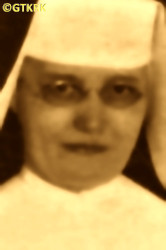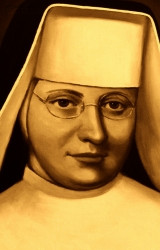Roman Catholic
St Sigismund parish
05-507 Słomczyn
85 Wiślana Str.
Konstancin deanery
Warsaw archdiocese, Poland
full list:
displayClick to display full list

searchClick to search full list by categories
wyświetlKliknij by wyświetlić pełną listę po polsku

szukajKliknij by przeszukać listę wg kategorii po polsku

Martyrology of the clergy — Poland
XX century (1914 – 1989)
personal data
religious status
blessed
surname
PESTKA
surname
versions/aliases
PESTKE
forename(s)
Anne (pl. Anna)
religious forename(s)
Mary Bona (pl. Maria Bona)

function
nun
creed
Latin (Roman Catholic) Church RCmore on
en.wikipedia.org
[access: 2014.09.21]
congregation
Congregation of the Sisters of st Catherine the Virgin and Martyr CSCmore on
pl.wikipedia.org
[access: 2013.05.19]
(i.e. Sisters of St Catherine)
diocese / province
Warmia diocesemore on
en.wikipedia.org
[access: 2018.09.02]
nationality
German
date and place
of death
01.05.1945

Ornetatoday: Orneta gm., Lidzbark Warmiński pov., Warmia‐Masuria voiv., Poland
more on
en.wikipedia.org
[access: 2022.01.28]
details of death
In 1940 contracted tuberculosis and from c. 1941 was treated in a hospital on Germ. St Andreasberg (Eng. St Andrew Hill) in Orneta, together with Sr Mary Abraham and Sr Dorothea Steffen, among others.
During the Russian winter offensive of 1945, ending World War II — started by the German and Russian invasion of Poland in 09.1939 — marked by repeated gang rapes, intimidation and abuse of women by Russian soldiers, in the face of the approaching Russian troops, carrying out their so‐called East Prussian operation, most of the hospital tried to evacuate towards Pieniężno, c. 16 km away, the Vistula Lagoon and the Pilawska Strait, from where the Germans attempted to get to the west via the Baltic Sea.
However, was already very ill and remained, together with several nuns, in the hospital.
On the night of 14‐15.02.1945, the Russians entered Orneta and the hospital.
Russian soldiers attacked the women who remained in the hospital, including patients, even the disabled.
They were shot blindly, abused, gang‐raped, tortured, and bayoneted.
Perished after about 8 weeks of suffering.
Sr Mary Abraham and Sr Dorothea Steffen perished also as a result of Russian rape.
cause of death
extermination: rape and murder
perpetrators
Russians
sites and events
Mass rapes in 1945Click to display the description, Ribbentrop‐MolotovClick to display the description, Pius XI's encyclicalsClick to display the description
date and place
of birth
1905

alt. dates and places
of birth
1903-1906
religious vows
30.04.1932 (temporary)
30.04.1935 (permanent)
positions held
c. 1941 – 1945
nun — Ornetatoday: Orneta gm., Lidzbark Warmiński pov., Warmia‐Masuria voiv., Poland
more on
en.wikipedia.org
[access: 2022.01.28] ⋄ Congregation's house, St Catherine Sisters CSC — hospital and sanatorium treatment — pulmonary tuberculosis
1932 – c. 1941
nun — Olsztyntoday: Olsztyn city pov., Warmia‐Masuria voiv., Poland
more on
en.wikipedia.org
[access: 2022.01.28] ⋄ Congregation's house, St Catherine Sisters CSC — ministry in the administration of St Mary's Hospital
21.10.1929 – 30.04.1932
novitiate — Braniewotoday: Braniewo urban gm., Braniewo pov., Warmia‐Masuria voiv., Poland
more on
en.wikipedia.org
[access: 2022.02.14] ⋄ Congregation's house, St Catherine Sisters CSC
1929
accession — St Catherine Sisters CSC
others related
in death
ABRAHAMClick to display biography Mary (Sr Mary Rolanda), ANGRICKClick to display biography Rosalie (Sr Mary Sabinella), BOLZClick to display biography Mary (Sr Mary Generosa), BÖNIGKClick to display biography Agatha Euphemia (Sr Mary Adelgarda), DOMNIKClick to display biography Mary (Sr Mary Liberia), FAHLClick to display biography Hedwig (Sr Mary Caritina), KLOMFASSClick to display biography Martha (Sr Mary Christophora), MARGENFELDClick to display biography Mary (Sr Mary Mauritia), MISCHKEClick to display biography Cecilia (Sr Mary Tiburtia), MÜLLERClick to display biography Catherine Elisabeth (Sr Mary Leonis), RAUTENBERGClick to display biography Barbara (Sr Mary Secundina), ROHWEDDERClick to display biography Mary (Sr Mary Xaveria), SCHRÖTERClick to display biography Mary (Sr Mary Gebharda), SKIBOWSKAClick to display biography Claire Anne (Sr Mary Aniceta), STEFFENClick to display biography Dorothea (Sr Mary Gunhilde)
sites and events
descriptions
Mass rapes in 1945: During capture in 1944‐1945 of pre‐war German territories and territories incorporated into Germany in 1939 after German invasion of Poland Russian soldiers committed mass, often multiple, rapes on mainly German, but also Polish, women. Up to 2 mln women might have been violated, from 8 to 80 or more years old. Many were murdered as a consequence. Rapes were prob. tolerated if not encouraged by Russian military and civilian NKVD commanders. (more on: en.wikipedia.orgClick to attempt to display webpage
[access: 2015.03.01])
Ribbentrop‐Molotov: Genocidal Russian‐German alliance pact between Russian leader Joseph Stalin and German leader Adolf Hitler signed on 23.08.1939 in Moscow by respective foreign ministers, Mr. Vyacheslav Molotov for Russia and Joachim von Ribbentrop for Germany. The pact sanctioned and was the direct cause of joint Russian and German invasion of Poland and the outbreak of the World War II in 09.1939. In a political sense, the pact was an attempt to restore the status quo ante before 1914, with one exception, namely the „commercial” exchange of the so‐called „Kingdom of Poland”, which in 1914 was part of the Russian Empire, fore Eastern Galicia (today's western Ukraine), in 1914 belonging to the Austro‐Hungarian Empire. Galicia, including Lviv, was to be taken over by the Russians, the „Kingdom of Poland” — under the name of the General Governorate — Germany. The resultant „war was one of the greatest calamities and dramas of humanity in history, for two atheistic and anti‐Christian ideologies — national and international socialism — rejected God and His fifth Decalogue commandment: Thou shall not kill!” (Abp Stanislav Gądecki, 01.09.2019). The decisions taken — backed up by the betrayal of the formal allies of Poland, France and Germany, which on 12.09.1939, at a joint conference in Abbeville, decided not to provide aid to attacked Poland and not to take military action against Germany (a clear breach of treaty obligations with Poland) — were on 28.09.1939 slightly altered and made more precise when a treaty on „German‐Russian boundaries and friendship” was agreed by the same murderous signatories. One of its findings was establishment of spheres of influence in Central and Eastern Europe and in consequence IV partition of Poland. In one of its secret annexes agreed, that: „the Signatories will not tolerate on its respective territories any Polish propaganda that affects the territory of the other Side. On their respective territories they will suppress all such propaganda and inform each other of the measures taken to accomplish it”. The agreements resulted in a series of meeting between two genocidal organization representing both sides — German Gestapo and Russian NKVD when coordination of efforts to exterminate Polish intelligentsia and Polish leading classes (in Germany called «Intelligenzaktion», in Russia took the form of Katyń massacres) where discussed. Resulted in deaths of hundreds of thousands of Polish intelligentsia, including thousands of priests presented here, and tens of millions of ordinary people,. The results of this Russian‐German pact lasted till 1989 and are still in evidence even today. (more on: en.wikipedia.orgClick to attempt to display webpage
[access: 2015.09.30])
Pius XI's encyclicals: Facing the creation of two totalitarian systems in Europe, which seemed to compete with each other, though there were more similarities than contradictions between them, Pope Pius XI issued in 03.1937 (within 5 days) two encyclicals. In the „Mit brennender Sorge” (Eng. „With Burning Concern”) published on 14.03.1938, condemned the national socialism prevailing in Germany. The Pope wrote: „Whoever, following the old Germanic‐pre‐Christian beliefs, puts various impersonal fate in the place of a personal God, denies the wisdom of God and Providence […], whoever exalts earthly values: race or nation, or state, or state system, representatives of state power or other fundamental values of human society, […] and makes them the highest standard of all values, including religious ones, and idolizes them, this one […] is far from true faith in God and from a worldview corresponding to such faith”. On 19.03.1937, published „Divini Redemptoris” (Eng. „Divine Redeemer”), in which criticized Russian communism, dialectical materialism and the class struggle theory. The Pope wrote: „Communism deprives man of freedom, and therefore the spiritual basis of all life norms. It deprives the human person of all his dignity and any moral support with which he could resist the onslaught of blind passions […] This is the new gospel that Bolshevik and godless communism preaches as a message of salvation and redemption of humanity”… Pius XI demanded that the established human law be subjected to the natural law of God , recommended the implementation of the ideal of a Christian state and society, and called on Catholics to resist. Two years later, National Socialist Germany and Communist Russia came together and started World War II. (more on: www.vatican.vaClick to attempt to display webpage
[access: 2023.05.28], www.vatican.vaClick to attempt to display webpage
[access: 2023.05.28])
sources
personal:
gross-kleeberg.deClick to attempt to display webpage
[access: 2013.05.19], newsaints.faithweb.comClick to attempt to display webpage
[access: 2013.06.23], katarzynki.org.plClick to attempt to display webpage
[access: 2015.03.01], www.studiawarminskie.uwm.edu.plClick to attempt to display webpage
[access: 2014.03.21], www.moikrewni.plClick to attempt to display webpage
[access: 2014.03.21]
original images:
www.findagrave.comClick to attempt to display webpage
[access: 2025.02.11], katarzynki.org.plClick to attempt to display webpage
[access: 2015.03.01]
LETTER to CUSTODIAN/ADMINISTRATOR
If you have an Email client on your communicator/computer — such as Mozilla Thunderbird, Windows Mail or Microsoft Outlook, described at WikipediaPatrz:
en.wikipedia.org, among others — try the link below, please:
LETTER to CUSTODIAN/ADMINISTRATORClick and try to call your own Email client
If however you do not run such a client or the above link is not active please send an email to the Custodian/Administrator using your account — in your customary email/correspondence engine — at the following address:

giving the following as the subject:
MARTYROLOGY: PESTKA Anne
To return to the biography press below:
 Click to return to biography
Click to return to biography










